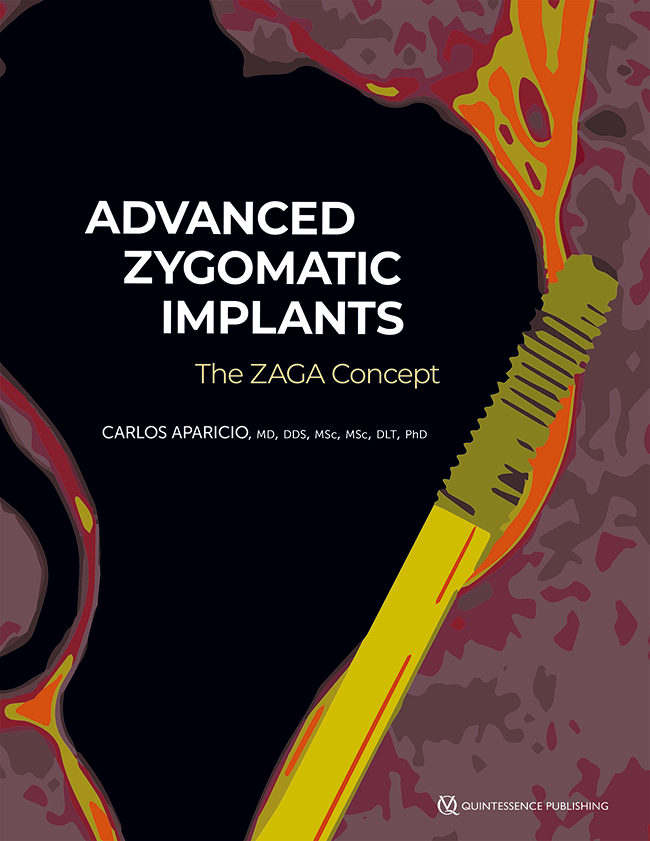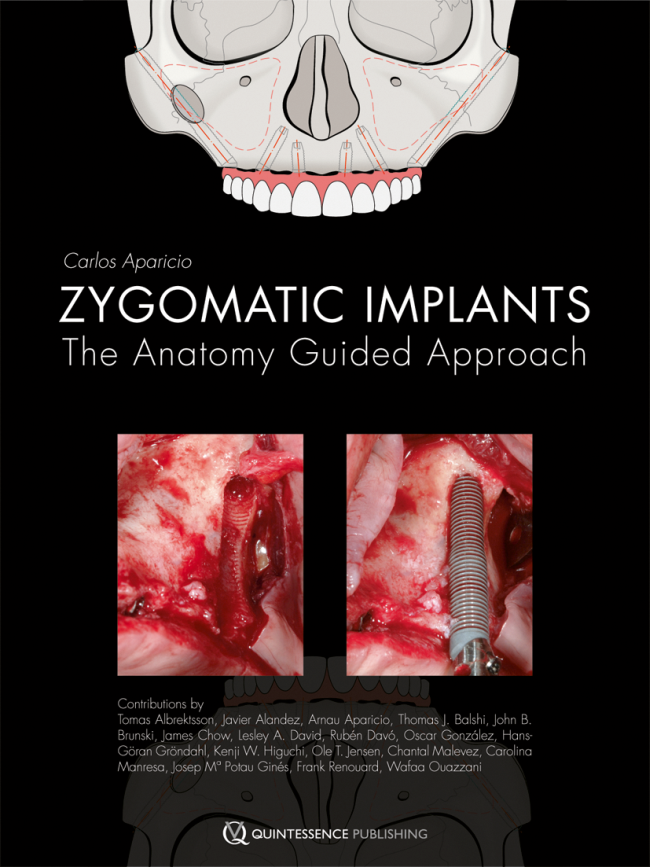International Journal of Periodontics & Restorative Dentistry, 2/2025
DOI: 10.11607/prd.7048, PubMed-ID: 38363183Seiten: 239-252, Sprache: EnglischAparicio, Carlos / Aparicio, ArnauOral rehabilitation of the atrophic maxilla using prostheses anchored by zygomatic implants (ZIs) is a well-documented process. To prevent the risk of sinusitis and/or oroantral communication, the placement of ZIs with an externalized path has been proposed. In cases where sealing the implant neck depends exclusively on a hemidesmosome junction, there is a risk of dehiscence in the soft tissue that can lead to esthetic problems, bone resorption, oroantral communication, cellulitis, and even orbital infection. To avoid soft tissue recession in implants placed buccal to the remaining ridge, the simplest procedure is to ensure good buccal coverage of the implant via keratinized tissue. Use of a double pedicle palatal flap is proposed to increase the keratinized tissue buccal to the implant while facilitating the incision closure by primary intention.
International Journal of Oral Implantology, 3/2023
PubMed-ID: 37767617Seiten: 225-242, Sprache: EnglischAparicio, Carlos / Pastorino, DavidBackground: Studies on different surgical approaches have been published with excellent success rates for zygomatic implants. The same publications offer different results regarding the complications associated with the use of such implants. A consensus protocol on zygomatic implant interventions has yet to be documented.
Purpose: To seek to establish a consensus at each step of treatment consisting of oral rehabilitation using zygomatic implant–anchored restorations, and to share the outcome of the process to serve as a basis for practitioners and researchers.
Materials and methods: A wide variety of protocols were identified based on the results of a literature review conducted previously. All participants received the results of the systematic literature search. A modified Delphi process was used to establish a consensus protocol. Six sections were defined: Diagnosis and indications, Planning, Medication, Surgery, Prosthesis, and Follow-up. The first round of 17 open-ended questions was shared with 63 participants, all of whom were experts in zygomatic implant rehabilitation and part of the ZAGA Centers network. A total of 77 follow-up questions were then generated after analysis of the responses to the first 17 questions.
Results: Of the 63 experts enrolled, 48 responded to both rounds of questions. Consensus was determined based on the percentage of agreement: < 70% was considered “no consensus” and ≥ 70% was considered “consensus”. A high level of consensus was reached. The sections with the lowest percentage of agreement were Medication and Surgery, where a consensus was reached for 67% of the questions. Of the questions included in the Follow-up section in both rounds, a consensus was reached for 80%. Overall, agreement was obtained on 71% of the topics.
Conclusions: Use of the modified Delphi process led to the creation of the first consensus protocol for oral restorations anchored to zygomatic implants.
Schlagwörter: consensus, Delphi process, zygomatic implants, zygomatic process, zygomatic protocols
The authors declare there are no conflicts of interest relating to this study.
The International Journal of Oral & Maxillofacial Implants, 4/2021
DOI: 10.11607/jomi.8603Seiten: 807-817, Sprache: EnglischAparicio, Carlos / Polido, Waldemar D / Chow, James / David, Lesley / Davo, Rubén / De Moraes, Eduardo Jose / Fibishenko, Alex / Ando, Masami / Mclellan, Guy / Nicolopoulos, Costa / Pikos, Michael A / Zarrinkelk, Hooman / Balshi, Thomas J / Peñarrocha, Miguel
Purpose: This cross-sectional study aimed to identify and characterize the pathway for appropriate placement of four zygomatic implants in the severely atrophic maxilla and to group the anatomical variations of the osteotomy trajectory for anterior zygomatic implants.
Materials and methods: CBCT images of patients presenting indications for the use of four zygomatic implants to withstand a maxillary rehabilitation were reviewed. Cross-sectional planes corresponding to the implant trajectories, designed according to a zygoma anatomy-guided approach for implants placed in the anterior and posterior maxilla, were assessed separately. The relationship of the implant osteotomy trajectory with the correlated residual alveolar bone, nasal and sinus cavities, maxillary wall, and zygomatic bone anatomies was established.
Results: The study population included 122 globally recruited patients, with 488 zygomatic implants, 244 of which had their starting point on the anterior incisor-canine area and 244 on the posterior premolar-molar area. The anatomy of the osteotomy path designed for the anterior implants ("A") was named and grouped into five assemblies from zygomatic anatomy-guided ZAGA A-0 to A-4, representing 2.9%, 4.5%, 19.7%, 55.7%, and 17.2% of the studied sites. Percentages for posterior implant ("P") trajectories of the osteotomy were grouped and named as ZAGA P-0 to P-4, representing 5.7%, 10.2%, 8.2%, 18.4%, and 57.4% of the sites, respectively. Approximately 70% of the population presented anatomical intra-individual differences.
Conclusion: The trajectory of the zygomatic implant followed different anatomical pathways depending on its coronal point being anteriorly or posteriorly located, which justifies a new zygoma anatomy-guided approach classification for anteriorly placed zygomatic implants. Topographic characteristics of the anatomical structures that are cut by an anterior oblique plane joining the lateral incisor-canine area to the zygomatic bone, representing the planned anterior osteotomy path in a quadruple-zygoma indication, have not been previously reported. Adaptation of surgical procedures and implant sections/designs to individual patients' anatomical characteristics is essential to reduce early and long-term complications.
Schlagwörter: cross-sectional studies, maxillary atrophy, zygoma, zygoma anatomy-guided approach, zygomatic implants
The International Journal of Oral & Maxillofacial Implants, 2/2020
Online OnlyDOI: 10.11607/jomi.8065, PubMed-ID: 32142581Seiten: e21-e26, Sprache: EnglischAparicio, Carlos / Antonio, SanzDifferent surgical approaches including the slot and the extrasinus techniques have been described to overcome disadvantages of the original Brånemark technique for the placement of zygomatic implants. A new concern associated with zygomatic implants placed externally to the maxillary wall is the possibility of disturbing buccal soft tissues, ending up with a dehiscence and a potential infective problem. Recently, a new methodology known as the Zygoma Anatomy-Guided Approach (ZAGA) has been described based on the concept of delivering specific therapy for each patient. ZAGA involves a variety of possibilities of implant trajectory from the intrasinus to an eventual extrasinus passage according to variations in patient anatomy. ZAGA methodology includes a rationale of how to prevent most of the reported complications of zygomatic implants. The objective of this technical note is to introduce the "Scarf Graft" as a part of the ZAGA protocol intended to prevent soft tissue dehiscence around extramaxillary zygomatic implants. A pediculated connective tissue graft is placed around the neck of the extramaxillary zygomatic implants. The increased connective tissue thickness consistently gives stable gingival tissue for prevention of recession. Currently, the treatment of soft tissue dehiscence around zygomatic implants does not have predictable results. Protocols for its prevention, such as the proposed ZAGA Scarf Graft, should be incorporated if an eventual dehiscence is foreseen.
Schlagwörter: extramaxillary implants, Scarf Graft, soft tissue dehiscence, soft tissue recession, ZAGA, zygomatic implants
The International Journal of Oral & Maxillofacial Implants, 2/2020
DOI: 10.11607/jomi.7488, PubMed-ID: 32142574Seiten: 366-378, Sprache: EnglischAparicio, Carlos / López-Piriz, Roberto / Albrektsson, TomasZygomatic-related implant rehabilitation differs from traditional implant treatment in biomechanics, clinical procedures, outcomes, and eventual complications such as soft tissue incompetence or recession that may lead to recurrent sinus/soft tissue complications. The extreme maxillary atrophy that indicates the use of zygomatic implants prevents use of conventional criteria to describe implant success/failure. Currently, results and complications of zygomatic implants reported in the literature are inconsistent and lack a standardized systematic review. Moreover, protocols for the rehabilitation of the atrophic maxilla using zygomatic implants have been in continuous evolution. The current zygomatic approach is relatively new, especially if the head of the zygomatic implant is located in an extramaxillary area with interrupted alveolar bone around its perimeter. Specific criteria to describe success/survival of zygomatic implants are necessary, both to write and to read scientific literature related to zygomatic implant–based oral rehabilitations. The aim of this article was to review the criteria of success used for traditional and zygomatic implants and to propose a revisited Zygomatic Success Code describing specific criteria to score the outcome of a rehabilitation anchored on zygomatic implants. The ORIS acronym is used to name four specific criteria to systematically describe the outcome of zygomatic implant rehabilitation: offset measurement as evaluation of prosthetic positioning; rhino-sinus status report based on a comparison of presurgical and postsurgical cone beam computed tomography in addition to a clinical questionnaire; infection permanence as evaluation of soft tissue status; and stability report, accepting as success some mobility until dis-osseointegration signs appear. Based on these criteria, the assessment of five possible conditions when evaluating zygomatic implants is possible.
Schlagwörter: criteria of success, ORIS, review (narrative), ZAGA, zygomatic implants, zygomatic success code
International Journal of Oral Implantology, 3/2011
PubMed-ID: 22043470Seiten: 269-275, Sprache: EnglischAparicio, CarlosPurpose: The aim of the present cross-sectional study was to propose a classification system based on a cross-sectional survey of zygomatic implant cases.
Materials and methods: Cone beam computerised tomography (CBCT) postoperative images and clinical intra-surgery photographs of 200 sites corresponding to 100 patients, treated with a total of 198 zygomatic implants in the maxilla according to an anatomy-driven prosthetic approach, were reviewed with regard to anatomy and pathway of the zygomatic implant body. The patients were consecutively selected independently of the type of surgery performed, with the unique requirement of a post-surgical CBCT performed at the moment of selection. Of special interest was the morphology of the lateral sinus wall, residual alveolar crest and the zygomatic buttress. An attempt was made to divide the patients into groups, describing typical anatomies and implant pathways.
Results: Five basic skeletal forms of the zygomatic buttress-alveolar crest complex and subsequent implant pathways could be identified in a sample of 100 patients. Out of them, 62% were female and 38% male, with ages varying between 36 and 83 years (mean age 59.6, SD: 9.67). The five groups were classified as ZAGA 0 to 4 representing 15%, 49%, 20.5%, 9% and 6.5% of the studied sites, respectively. Intra-individual anatomical differences affecting the zygomatic buttress-alveolar crest complex was also found in 58% of the patients.
Conclusions: Five typical anatomical and implant pathway situations could be identified. A classification system comprising five groups named ZAGA 0 to 4 is proposed. Anatomical intra-individual differences were also found in the 58% of the studied population. It is believed that the proposed classification system is useful for categorising zygomatic implant cases for therapy planning and for scientific follow-up purposes.
Schlagwörter: atrophic maxilla, dental implants, extra-sinus pathway, zygomatic implants
The International Journal of Oral & Maxillofacial Implants, 5/1995
Seiten: 614-618, Sprache: EnglischAparicio, CarlosWhen carrying out restorations supported by dental implants, it is advisable to have a temporary method that offers the possibility of evaluating and/or creating a proper emergence profile, peri-implant health, occlusion, esthetics, acceptable phonetic response, and hygiene, as well as one that facilitates progressive loading of the implants during the bone maturation period. To maintain osseointegration it is essential that a prosthesis fit with total passivity, since the lack of a periodontal ligament renders the implant unable to modify its position. Gold cylinders for EsthetiCone abutments, which were modified following a previously reported technique, were used so that provisional prostheses could be fixed to the cylinders in the mouth by means of an alternative cementing technique. By this way, a provisional prosthesis with total circumferential fit, maintaining the option of retrieval, could be routinely obtained.
Schlagwörter: interim prostheses, osseointegration, passive fit
The International Journal of Oral & Maxillofacial Implants, 1/1993
Seiten: 61-67, Sprache: EnglischAparicio, Carlos / Brånemark, Per-lngvar / Keller, Eugene E. / Olivé, JordiThe simultaneous use of autogenous bone grafts and osseointegrated implants has opened up new possibilities in the reconstruction of large tissue defects in the oral-maxillofacial region. In this paper, the successful rehabilitation of a patient who lost the premaxilla following a segmental osteotomy is described. The resulting oronasal communication and bony defect were restored by placing a bone graft from the iliac crest that was stabilized with two osseointegrated implants. A fixed prosthesis was fabricated to replace the missing anterior teeth. Esthetic and functional criteria were fulfilled.
Schlagwörter: autologous graft, osseointegrated implants, premaxillary necrosis
The International Journal of Oral & Maxillofacial Implants, 1/1992
Seiten: 94-103, Sprache: EnglischAparicio, Carlos / Olivé, JordiThe chemical composition and topography of an implant surface determine the human immunologic system response. This study compared the surfaces of 13 Brånemark oral implants, 11 that came from retrieved specimens which failed initially or did not osseointegrate and 2 that were never implanted (controls). The period of implantation in human jaws varied between 3 and 20 months. After cleaning and sterilization, the topography, surface chemical composition, and thickness of the oxide layer were studied. The results obtained with scanning electron microscopy did not show any significant topographic differences among the specimens. X-ray spectrographic microanalysis showed very similar composition (titanium and amounts less than 0.5% of other elements) in the outermost layer of the analyzed specimens. The Auger spectroscope revealed considerable percentage differences in the amount of carbon and silicon in the last monolayers, which could be attributed to handling or to an inadequate cleaning process. This places the retrieved specimens out of the acceptable statistical limits of contamination by introducing a factor of doubt for long-term prognosis in the hypothetical situation of their re-use.
Schlagwörter: failed implants, microanalysis, osseointegration, surfaces
The International Journal of Oral & Maxillofacial Implants, 4/1990
Seiten: 390-400, Sprache: EnglischOlivé, Jordi / Aparicio, CarlosOral implant stability is essential for optimal function. Results obtained from the Periotest measurement of the stability of 204 commercially pure titanium implants, consecutively placed in 22 maxillae and 24 mandibles according to the Brånemark procedure, are reported. Preliminary results suggest that the Periotest value of an oral implant is an objective and easily applied criterion for stability assessment. Since osseointegration is achieved gradually over time, this test may assist the clinician in deciding whether to extend the healing period before loading fixtures that seem clinically and radiologically integrated but give borderline Periotest values.
Schlagwörter: clinical material, osseointegrated dental implants, Periotest, stability, tissue damping





